




Your support is critical to our success.

Origin and Habitat: Garden origin (Nursery produced hybrid)
Synonyms:
Description: It is a small slow growing solitary "living rock" cactus obtained by crossing ♀ Ariocarpus fissuratusSN|2079]]SN|2114]] var. lloydii x ♂ Ariocarpus retusus. The superb features of this rare plant are due to the intersection between the traits of the ancestors. It has inherited by Ariocarpus retususSN|2079]]SN|2079]] the triangular tubercles which are however more stocky and rounded like in Ariocarpus lloydi with slightly papillate surface. The flower are also very beautiful. This hybrid is very variable and differences among specimens may be considerable.
Habit: It is a geophyte plant that produces a small star-shaped rosette of rough fleshy tubercles.
Stem: Subglobose, flattened on top, 5-10 cm high, that grows extremely slowly, to 10-15 (or more) cm in diameter. The stem is usually solitary, rarely giving rise to side shoots from old areoles.
Tubercles: Imbricated, triangular, but more rounded than in Ariocarpus retususSN|2114]]SN|2079]], broad at base and usually acute at the apexes, flattened to convex adaxially, greenish-brown, greyish-green, yellowish-green or olive-green, irregularly papillose (or are only weakly fissured) in the surface which form transversal ledges and irregularly warty, usually as long as wide (to 3-4 cm long), and with the edges more or less acute.
Areoles: Apical or sub-apical only in young specimens.
Spines: It have no spines.
Roots: Each plant has a large turnip-like taproot, which lies below the soil surface and serves for water storage.
Flowers: These plants have a woolly crown, from which emerge white to pink flowers up to 5 cm in diameter, 2 times wider than long when fully expanded. Flowers last for 3 to 4 days.
Blooming season: October, November.
Fruits: Not seen.
Subspecies, varieties, forms and cultivars of plants belonging to the Ariocarpus hybrid group
Cultivation and Propagation: It’s a relatively easy species to cultivate, but very slow growing. Needs a very well drained soil. Requires strong sun to part sun to develop good spinal growth and waterings should be rather infrequent, to keep the plant compact and not become excessively elongated and unnatural in appearance. Keep dry in winter, or when night temperatures remain below 10° C (but some people give this plant a light monthly watering to prevent the drying and shedding of the lower tubercles.) it is hardy to -4°C for a short period. Assure a good ventilation.
Propagation: It can be reproduced by seeds. Young seedlings are tiny and they need several years to reach adult size, and require very careful watering. Many growers graft tiny 2-3 month seedlings and they grow on very successfully that way.
| Your Actions | |
|---|---|
| Back to Ariocarpus index | |
| Back to Cactaceae index | |
 |
Back to Cacti Encyclopedia index |
Privacy stantement - Terms and conditions - How to cite - About us - Feedback - Donate




